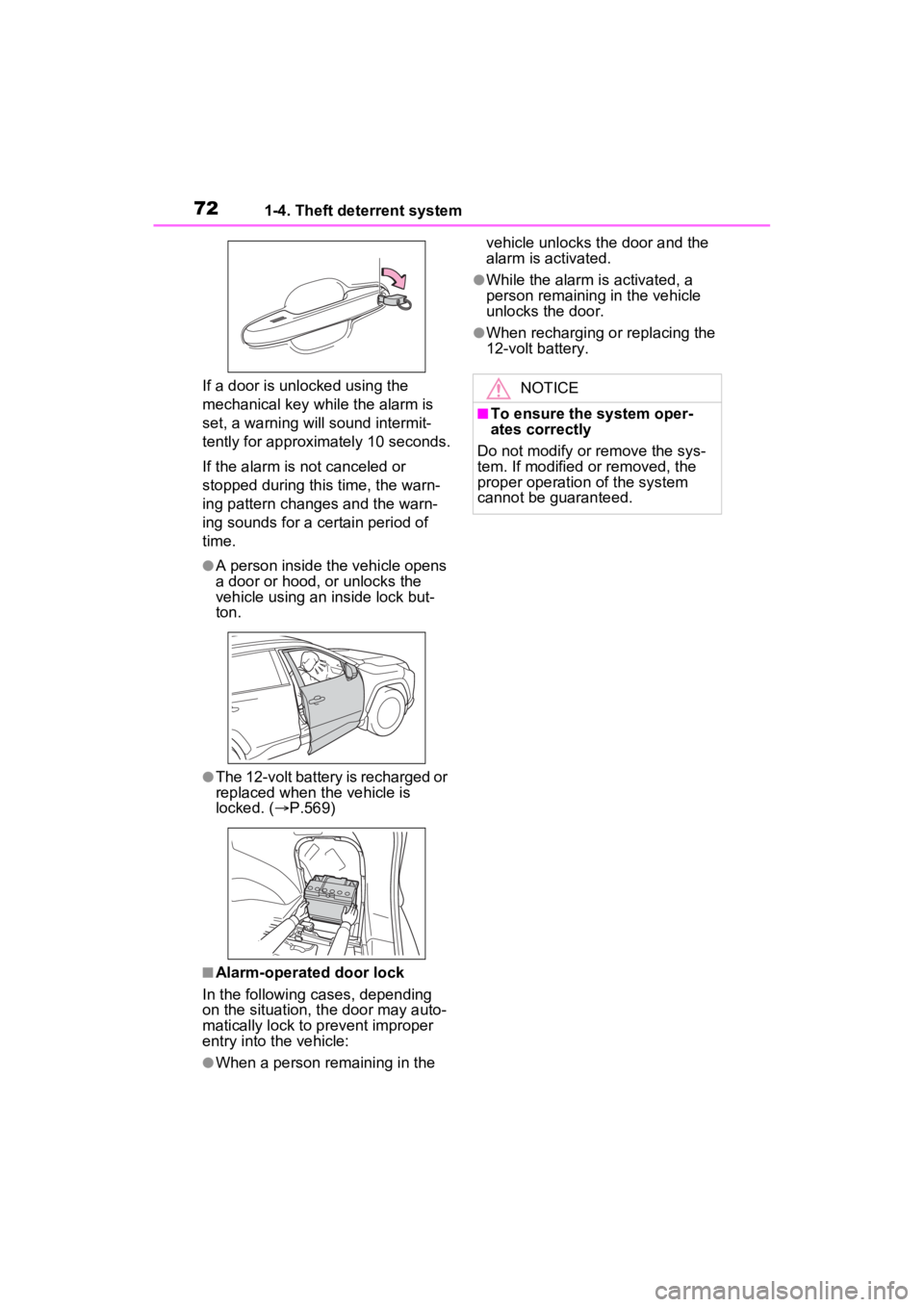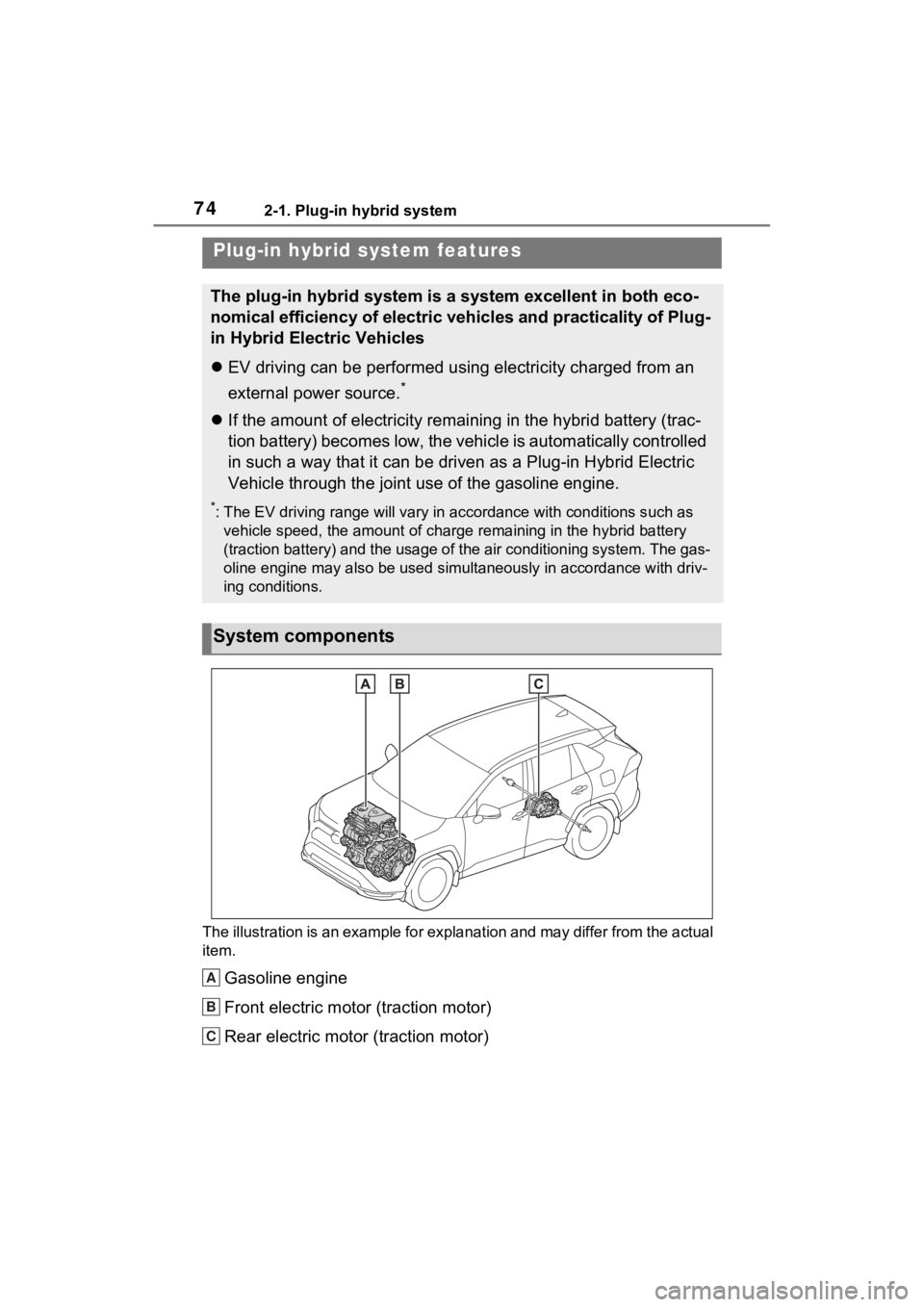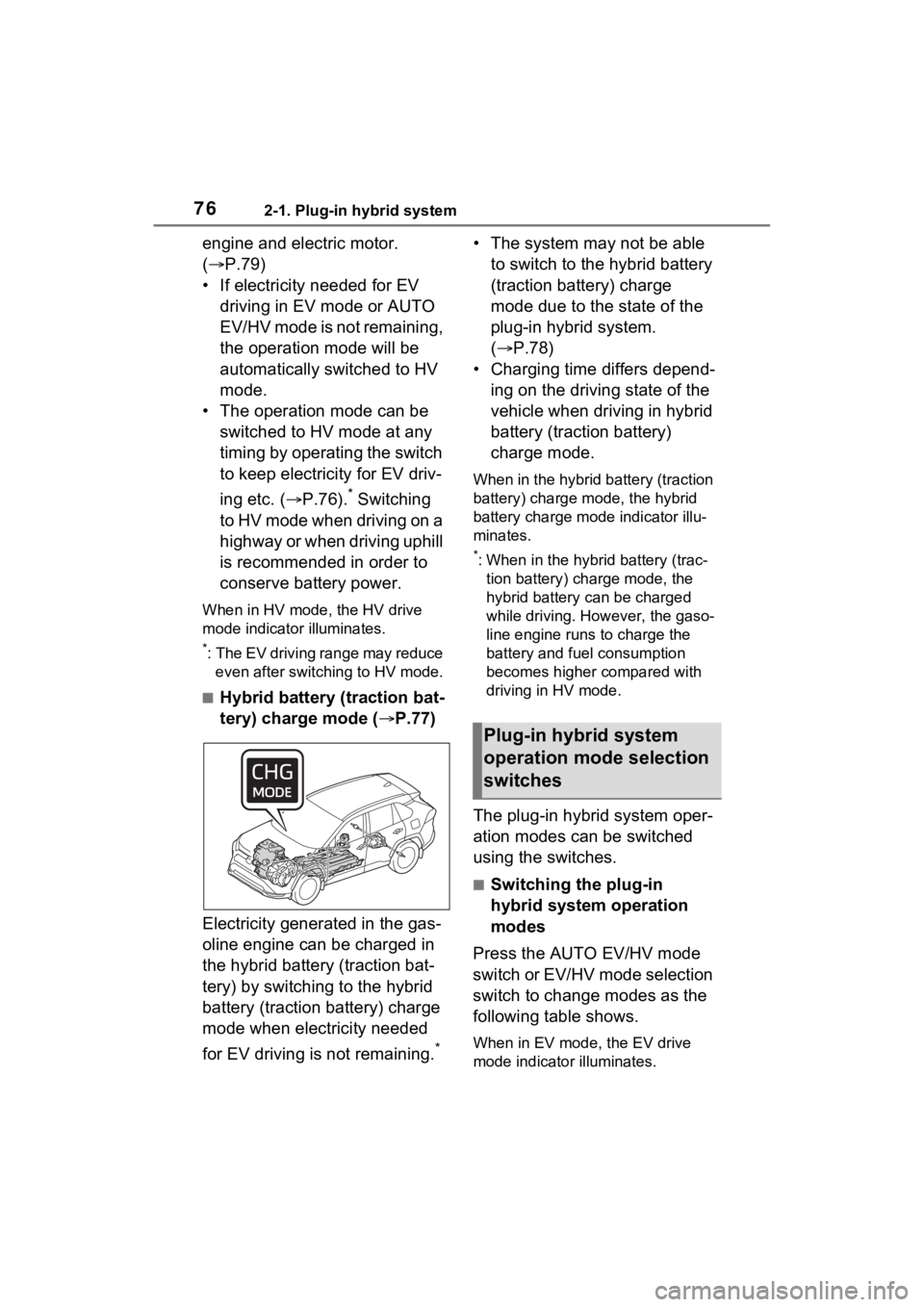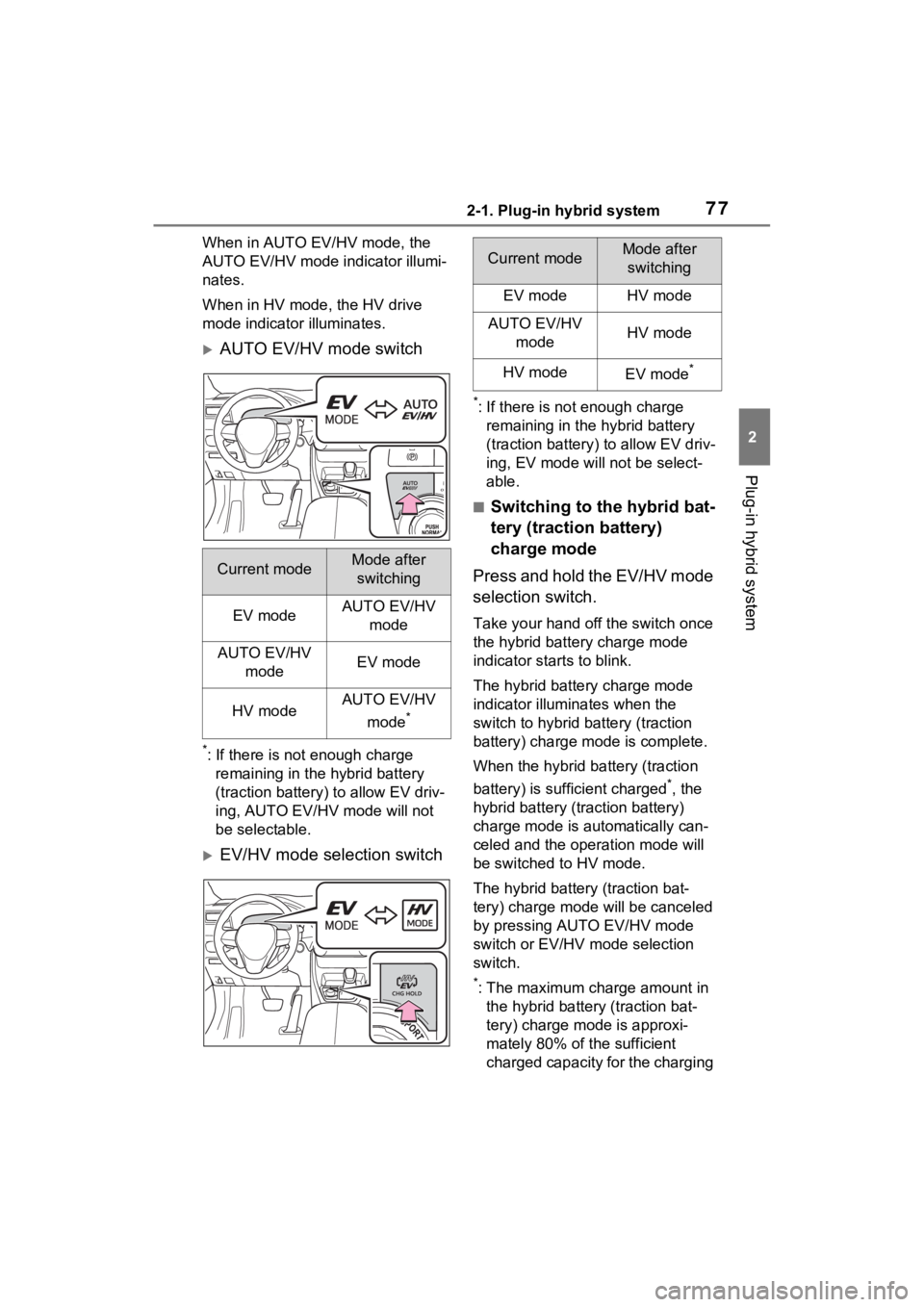2023 TOYOTA RAV4 PRIME battery
[x] Cancel search: batteryPage 1 of 662

RAV4 PRIME_OM_OM42E79U_(U)
1
2
3
4
5
6
7
8
9
10
Pictorial indexSearch by illustration
For safety
and securityMake sure to read through them
(Main topics: Child seat, theft deterrent system)
Plug-in hybrid
systemPlug-in hybrid system features, charging method,
etc.
(Main topics: Driving tips, charging methods)
Vehicle status
information and
indicatorsReading driving-related information
(Main topics: Meters, multi-information display)
Before driving
Opening and closing the doors and windows,
adjustment before driving
(Main topics: Keys, doors, seats, power windows)
Driving
Operations and advice which are necessary for
driving
(Main topics: Starting hybrid system, refueling)
Interior featuresUsage of the interior features
(Main topics: Air conditioner, storage features)
Maintenance
and careCaring for your vehicle and maintenance
procedures
(Main topics: Interior and exterior, light bulbs)
When trouble
arisesWhat to do in case of malfunction and emergency
(Main topics: 12-volt battery discharge, flat tire)
Vehicle
specificationsVehicle specifications, customizable features
(Main topics: Fuel, oil, tire inflation pressure)
For ownersReporting safety defects for U.S. owners, and seat
belt, SRS airbag and headlight aim instructions for
Canadian owners
IndexSearch by symptom
Search alphabetically
Page 4 of 662

4TABLE OF CONTENTS
Parking Support Brake func-tion (rear-crossing vehicles).................................... 402
Driving mode select switch .................................... 404
Trail Mode ..................... 405
Driving assist systems .. 407
5-6. Driving tips Winter driving tips ......... 413
Utility vehicle precautions .................................... 416
6-1. Using the air conditioning
system and defogger
Automatic air conditioning
system ......................... 422
Remote Air Conditioning System ........................ 431
Heated steering wheel/Front seat heaters/Front seat
heaters and ventila-
tors/Rear seat heaters. 433
6-2. Using the interior lights Interior lights list ............ 436
6-3. Using the storage features List of storage features . 438
Luggage compartment fea- tures ............................ 442
6-4. Using the other interior fea- tures
Other interior features ... 445
Power outlet (AC 120 V/1500 W)................................ 455
When the power outlet (AC 120 V 1500 W) cannot be
used properly .............. 461Garage door opener ......
463
7-1. Maintenance and care Cleaning and protecting the vehicle exterior ............ 472
Cleaning and protecting the vehicle interior ............. 475
7-2. Maintenance Maintenance requirements.................................... 478
General maintenance .... 480
Emission inspection and maintenance (I/M) pro-
grams .......................... 482
7-3. Do-it-yourself maintenance Do-it-yourself service pre-cautions ....................... 484
Hood .............................. 486
Positioning a floor jack .. 487
Engine compartment ..... 489
12-volt battery................ 495
Tires .............................. 497
Tire inflation pressure .... 509
Wheels .......................... 511
Air conditioning filter ...... 513
Cleaning the DC/DC Con- verter air intake vent and fil-
ter ................................ 515
Wiper insert replacement .................................... 519
Electronic key battery .... 522
Checking and replacing fuses ............................ 524
Headlight aim ................ 527
Light bulb
s ..................... 528
6Interior features
7Maintenance and care
Page 5 of 662

5TABLE OF CONTENTS
1
2
3
4
5
6
7
8
9
10
8-1. Essential informationEmergency flashers ...... 534
If your vehicle has to be stopped in an emergency.................................... 535
If the vehicle is submerged or water on the road is rising.................................... 536
8-2. Steps to take in an emer- gency
If your vehicle needs to be towed........................... 538
If you think something is wrong .......................... 540
If a warning light turns on or a warning buzzer sounds
.................................... 541
If a warning message is dis- played.......................... 552
If you have a flat tire...... 557
If the hybrid system will not start ............................. 564
If you lose your keys ..... 566
If the fuel filler door cannot be opened ................... 566
If the electronic key does not operate properly .......... 567
If the 12-volt battery is dis- charged ....................... 569
If your vehicle overheats 574
If the vehicle becomes stuck .................................... 5789-1. Specifications
Maintenance data (fuel, oil level, etc.) .................... 580
Fuel information............. 587
Tire information ............. 589
9-2. Customization Customizable features... 599
9-3. Initialization Items to initialize ............ 615
10-1.For owners Reporting safet y defects for
U.S. owners ................. 618
Reporting safet y defects for
Canadian owners ........ 619
Seat belt instructions for Canadian owners (in
French) ........................ 619
SRS airbag instructions for Canadian owners (in
French) ........................ 621
Headlight aim instructions for Canadian owners (in
French) ........................ 628
What to do if... (Trouble- shooting) ..................... 632
Alphabetical Index ........ 635
8When trouble arises9Vehicle specifications
10For owners
Index
Page 72 of 662

721-4. Theft deterrent system
If a door is unlocked using the
mechanical key while the alarm is
set, a warning will sound intermit-
tently for approximately 10 seconds.
If the alarm is not canceled or
stopped during this time, the warn-
ing pattern change s and the warn-
ing sounds for a certain period of
time.
●A person inside the vehicle opens
a door or hood, or unlocks the
vehicle using an inside lock but-
ton.
●The 12-volt battery is recharged or
replaced when the vehicle is
locked. ( P.569)
■Alarm-operated door lock
In the following cases, depending
on the situation, th e door may auto-
matically lock to p revent improper
entry into the vehicle:
●When a person remaining in the vehicle unlocks the door and the
alarm is activated.
●While the alarm i
s activated, a
person remaining in the vehicle
unlocks the door.
●When recharging or replacing the
12-volt battery.
NOTICE
■To ensure the system oper-
ates correctly
Do not modify or remove the sys-
tem. If modified or removed, the
proper operation of the system
cannot be guaranteed.
Page 74 of 662

742-1. Plug-in hybrid system
2-1.Plug-in hybrid system
The illustration is an example for explanation and may differ from the actual
item.
Gasoline engine
Front electric motor (traction motor)
Rear electric motor (traction motor)
Plug-in hybrid system features
The plug-in hybrid system is a system excellent in both eco-
nomical efficiency of electric vehicles and practicality of Plug-
in Hybrid Electric Vehicles
EV driving can be performed using electricity charged from an
external power source.
*
If the amount of electricity remaining in the hybrid battery (t rac-
tion battery) becomes low, the vehicle is automatically controlled
in such a way that it can be driven as a Plug-in Hybrid Electri c
Vehicle through the joint use of the gasoline engine.
*: The EV driving range will vary in accor dance with conditions such as
vehicle speed, the amount of charge remaining in the hybrid bat tery
(traction battery) and the usage of the air conditioning system . The gas-
oline engine may also be used si multaneously in accordance with driv-
ing conditions.
System components
A
B
C
Page 75 of 662

752-1. Plug-in hybrid system
2
Plug-in hybrid system
The plug-in hybrid system oper-
ates in the following modes.
The multi-information display can
be used to check which mode the
plug-in hybrid system is currently
being driven in. (P.185, 196)
■EV mode
When a sufficient amount of
electricity is remaining after
charging
*1, EV driving is per-
formed using electricity stored in
the hybrid battery (traction bat-
tery).
*2
When in EV mode, the EV drive
mode indicator illuminates.
*1: The amount of remaining charge can be checked on the SOC
(State of Charge) gauge.
( P.173)
*2: Depending on the situation, EV
driving may be canceled and
both gasoline engine and electric
motor are used. ( P.80)
■AUTO EV/HV mode
Normally, the electricity stored
in the hybrid battery (traction
battery) is used for EV driving.
However, when more power is
required, such as for driving
uphill or accelerating suddenly,
the gasoline engine starts and
provides powerful acceleration
by strongly depressing the
accelerator pedal.
When the vehicle is in a condi-
tion where EV driving is possi-
ble, EV mode and AUTO EV/HV
mode can be switched by oper-
ating the switch. ( P.76)
When in AUTO EV/HV mode, the
AUTO EV/HV mode indicator illumi-
nates.
■HV mode
When in HV mode, the vehicle is
driven using both the gasoline
Plug-in hybrid system
operation mode
Page 76 of 662

762-1. Plug-in hybrid system
engine and electric motor.
(P.79)
• If electricity needed for EV driving in EV mode or AUTO
EV/HV mode is not remaining,
the operation mode will be
automatically switched to HV
mode.
• The operation mode can be switched to HV mode at any
timing by operating the switch
to keep electricity for EV driv-
ing etc. ( P.76).
* Switching
to HV mode when driving on a
highway or when driving uphill
is recommended in order to
conserve battery power.
When in HV mode, the HV drive
mode indicator illuminates.
*: The EV driving range may reduce even after switching to HV mode.
■Hybrid battery (traction bat-
tery) charge mode ( P.77)
Electricity generated in the gas-
oline engine can be charged in
the hybrid battery (traction bat-
tery) by switching to the hybrid
battery (traction battery) charge
mode when electricity needed
for EV driving is not remaining.
*
• The system may not be able to switch to the hybrid battery
(traction battery) charge
mode due to the state of the
plug-in hybrid system.
( P.78)
• Charging time differs depend- ing on the driving state of the
vehicle when driving in hybrid
battery (traction battery)
charge mode.
When in the hybrid battery (traction
battery) charge mode, the hybrid
battery charge mod e indicator illu-
minates.
*: When in the hybrid battery (trac- tion battery) charge mode, the
hybrid battery can be charged
while driving. Ho wever, the gaso-
line engine runs to charge the
battery and fuel consumption
becomes higher compared with
driving in HV mode.
The plug-in hybrid system oper-
ation modes can be switched
using the switches.
■Switching the plug-in
hybrid system operation
modes
Press the AUTO EV/HV mode
switch or EV/HV mode selection
switch to change modes as the
following table shows.
When in EV mode, the EV drive
mode indicator illuminates.
Plug-in hybrid system
operation mode selection
switches
Page 77 of 662

772-1. Plug-in hybrid system
2
Plug-in hybrid system
When in AUTO EV/HV mode, the
AUTO EV/HV mode indicator illumi-
nates.
When in HV mode, the HV drive
mode indicator illuminates.
AUTO EV/HV mode switch
*: If there is not enough charge remaining in the hybrid battery
(traction battery) to allow EV driv-
ing, AUTO EV/HV mode will not
be selectable.
EV/HV mode selection switch
*: If there is not enough charge remaining in the hybrid battery
(traction battery) to allow EV driv-
ing, EV mode will not be select-
able.
■Switching to the hybrid bat-
tery (traction battery)
charge mode
Press and hold the EV/HV mode
selection switch.
Take your hand off the switch once
the hybrid battery charge mode
indicator starts to blink.
The hybrid battery charge mode
indicator illuminates when the
switch to hybrid battery (traction
battery) charge mode is complete.
When the hybrid battery (traction
battery) is sufficient charged
*, the
hybrid battery (traction battery)
charge mode is automatically can-
celed and the operation mode will
be switched to HV mode.
The hybrid battery (traction bat-
tery) charge mo de will be canceled
by pressing AUTO EV/HV mode
switch or EV/HV m ode selection
switch.
*: The maximum charge amount in the hybrid battery (traction bat-
tery) charge mode is approxi-
mately 80% of the sufficient
charged capacity for the charging
Current modeMode after switching
EV modeAUTO EV/HV mode
AUTO EV/HV modeEV mode
HV modeAUTO EV/HV
mode
*
Current modeMode after switching
EV modeHV mode
AUTO EV/HV modeHV mode
HV modeEV mode*